Port Canaveral
-
- Port Canaveral: Leveraging the Past, Building for the Future Maritime Logistics Professional, Jan/Feb 2018 #20
The East Coast’s most diversified cruise port is poised for an exciting run at the future.
Almost 38 years ago, Port Canaveral, Florida had some minor cargo traffic, a large U.S. Navy presence, some submarines, and was homeport to an obscure fleet of specialized Military Sealift Command missile tracking vessels. And, not much else.Those who called at the port in those days couldn’t possibly have visualized then what the port has now become. That’s because the first cruise vessel port call was still almost a decade away and the development of the local physical infrastructure to support the cruise traffic that would eventually come, hadn’t yet been started. In contrast, today’s operating revenues will reach $100 million and the port has quietly moved up the ladder to become the world’s second busiest cruise port.Notwithstanding all of that impressive growth, Port Canaveral has no intention of sitting on its hands. Situated in the rapidly growing Southeastern United States, the port is forging ahead with a recently announced 30-year Strategic Master Plan. Hence, the next 30 years promise to be just as exciting as the previous 40. Quietly, Port Canaveral is developing its own unique signature, leveraging a business niche unlike anything else on the East Coast.In the BeginningThe master plan has been in development for over two years, and addresses each of the Port’s major businesses: cruise, cargo, parks and recreation, and commercial development, as well as the potential offered by the resurgence and growth of the space industry in the Port’s region. Port CEO Captain John Murray puts the document in perspective, saying, “The Plan presents various opportunities over the 30-year planning horizon, but not every project in this Plan may become a reality.” Today, roughly 80% of the port’s revenue stream is from the cruise business, and as much as 20% of that emanates from parking revenue. He explains, “Just like an airport. We’ve got a very unique business model here with respect to cruise.”In the beginning, it began with Premiere Cruise Line. Leveraging a partnership with Disney, this entailed cruises to the Bahamas from Port Canaveral. Eventually, Disney also built ships and the rest is history. Port Canaveral was firmly on the map as a cruise port, initially because of their close and convenient proximity to Orlando. At around the same time, other operators – Norwegian Cruise Line, Royal Caribbean, Carnival – all expanded their local footprint.Carnival eventually identified the port as an opportunity for drive-in customers. Separately, Disney decided that it would be a great complement to its theme park business. By 1999, the port’s cruise market had exploded. Part of that success can be attributed to location. Every port has some kind of challenge. Port Canaveral’s geographic advantages include direct access to the Atlantic Ocean with no bridges or air draft limitations, and a transit time from first buoy to dock of only 45 minutes. The Port’s central east coast Florida location, combined with uncongested easy access to major road and rail systems puts every major Florida market within three hours of the Port.A Different, Local Business ModelBeyond its four ‘anchor’ clients, Port Canaveral hosts as many as 20 different cruise lines, many of them so-called ‘independent’ cruise lines that provision, change out passengers and crew. Much of this traffic involves the increasingly popular practice of ‘theme’ cruises that cater to a narrow, but enthusiastic passenger base. Here, they can get off and go to the Space Center or head into Orlando for a Disney experience.With a nod to its two rivals to the south, Port Canaveral is cognizant of what can be and what will not. That business model has nothing to do with higher profile ports, and depends on a different demographic.Miami is the largest cruise port in the world and Port Everglades comes in at number 3 after Port Canaveral in terms of global passenger throughput. But, Port Everglades and Miami both primarily serve different markets, both relying on a strong international component. Royal Caribbean and Carnival are headquartered there. There’s a reason why Miami is number one, but both ports have their own challenges.Constrained by its physical footprint, Miami can’t expand without taking away from their cargo side. The answer to that challenge has been to rebuild old terminals and offer capabilities for the new ships. “They’re going to do fine at that. And it will always be the desired market for that international cruise passenger,” admits Murray. Similarly, Port Everglades finds itself in the same position: great connectivity to two major international airports but also limited by their ability to grow.According to David German, Port Canaveral’s Director, Cruise Business Development, Port Canaveral is different. “A majority of our cruise passengers are US citizens and Canadians. We are a big drive-in market and that’s a big plus in our favor. We’re balancing the Orlando theme park market, we’re complementing that, and then they complement our business.” Driving in from the regional Southeastern states, families will take a take a week off involving a 3-day cruise out of Port Canaveral and then spend 4 days at the theme parks.The drive-in market has its definite advantages. It eliminates the uncertainty of flight delays for those coming in for vacation, as well as the considerable cost of putting as many as four people on an airplane and then spending the night before the cruise in a local hotel. That’s not to say Canaveral customers don’t fly in. They do. But, here, they can be at the ship within an hour of departing Orlando International airport.A quick drive through Canaveral’s parking lots reveals a great deal. The autos hail from South Carolina, Georgia, Tennessee, and North Carolina. When they arrive, Port Canaveral is ready for them. That’s because even the smallest garage at the port has more than 1,000 parking spaces.Similar to the New Orleans model of selling a cruise and throwing in Bourbon Street as a bonus, Port Canaveral has its own unique draws, most of which translate into dollars for local businesses. A same day arrival and cruise ship boarding is far easier here than at southern Florida ports, but most people come in and spend the night. Those hotels trend towards the large suite-style, capable of putting multiple people in the same space. And, while some of that is a function of the cruise industry, it also leverages other attractions, as well.In practice, it is a solid business model and the local hoteliers are succeeding with it. Moreover, most of these hotels offer off-site parking at the hotels where they can hold vehicles so customers don’t have to pay the higher, premiere parking prices at the port.Not Just Cruising: Quadri-ModalPort Canaveral itself is not ‘quadri-modal,’ but Brevard County markets itself as such because it has airports, a space port, a sea port, and then of course, the land component. It is the not-so-obvious space connection with the rapidly growing commercial space industry that the port also has its eyes on.Tourism aside, the preferred method of recapturing rocket boosters for reuse involves a maritime presence and has a maritime component with offshore vehicles that they can land the boosters on, bring them back to the port, pull them off the conveyance, and recycle back into service at the Air Force base, or the, NASA facilities. Port Canaveral, already entrenched in that game, aims to be the preferred venue for all of that, as well.In addition to the commercial and support angle for the space component, those launches are also quite exciting to watch, as well. A recent launch proved that out and the passengers got a bonus on at least one Canaveral departure. “One of the cruise ships sailed – I won’t say which line but it was one of our Sunday vessels – and my wife and I are down the coast on the beach, and we went outside and thinking that ship should have been gone by now – it was 5:30, they’re normally long gone and passing by our place down there – and we looked out and there it was, waiting for the launch,” said Murray. With cruise ship transit schedules planned as they are, that kind of ad-hoc entertainment is a bonus for Canaveral-based cruise ship.LNG: Not Just for Ships AnymoreDriven by increasingly environmentally conscious operators, LNG-powered cruise vessels are coming. The recent news that Carnival Corporation had agreements in place to build eight LNG-powered cruise ships across four of its 10 global cruise brands brought that point home in no uncertain terms. Carnival isn’t alone in that effort.That’s got Port Canaveral’s attention. Murray says flatly, “We’re going to be the first cruise port, I believe, that will be ready to accept LNG vessels. If we’re the second largest cruise port in the world, then they are probably coming here.” He adds for emphasis, “You have to evolve with it as it goes.”The rapidly developing Crowley and Tote LNG bunkering operations just down the coast makes it clear that there will be many ways to get to the Promised Land. That involves both barge-based bunkering as well as fixed shoreside infrastructure. At Port Canaveral, all options are on the table. “Everybody wants to be in the LNG game,” explains Murray, adding, “At the end of the day, the relationship with the LNG supplier is between the cruise line, or the cargo line, and the supplier. What we’re here to do is facilitate whatever vehicle they want to use for LNG and make sure it happens.”The port’s goal is to come up with a system that works for everybody. “We don’t want to have four cruise lines with four different concepts of operation. We don’t have enough real estate to support that.” Lurking in the background is the deal between Harvey Gulf and Shell to build an ATB LNG carrier to supply bunkers to U.S.-based cruise lines. The changing landscape adds up to two things: LNG as a fuel is moving ahead, and the cruise industry is emerging as the primary driver. Port Canaveral aims to be at heart of that development.Port Canaveral also has other plans for this clean fuel. As the commercial space industry contemplates burning LNG as a primary fuel, the need for the local space community to source this energy becomes more important. Already serving the space industries maritime assets, Canaveral looks to do the same thing when it comes to fueling the rockets of tomorrow.For Port Canaveral, space, and not cruise ships, will be the initial driver for LNG. Murray puts the situation in perspective. “We’ve got the ships coming; we’ve got the rockets coming, all at the same time. The question is how are the rockets going to get LNG? And, for that matter, the ships?” The answer, he says, involves a LNG storage facility at the port. That approach allows the port to better service both space and marine. And, he says, “The most logical way to do it is through the port, by moving LNG in bulk.”The Master PlanIn the works for almost two years, the plan focuses on long-term uses for the port. That necessarily involves sorting out the local politics that we’re sorting through. Port Canaveral is a special district of the State of Florida, with five elected commissioners. As a special district, the port has the power to levy ad valorem taxes. Murray says that’s not going to happen. “We haven’t done that since 1986. We’re not going to do that. We survive on our revenues and government grants from the state and the federal level, but we do everything on our operating income.”Putting together the Master Plan spanned two years, in large part because of the resurgence of the space industry and the advent of the LNG piece. Neither variable could be easily predicted. In the end, the port knew that it had to (a.) be positioned for the future, (b.) recognize that ‘cruise’ is and will be its core business, and (c.) avoid trying to be something that the port is not.“We’re not going to be the new, large, booming container port,” Murray told MLpro, continuing, “We’ve got our container terminal and it’s evolving, but we recognize that it’s never going to be the size of Savannah. That’s not the market that we serve.”Separately, the commercial space industry needs the port. They can’t go to Jacksonville to make it work. Dave German explains, “We recognize the value of the space industry to the local community and surrounding areas in Central Florida. So being who we are in this community, it is incumbent upon us to make sure that that industry is successful. It is not going to be sufficient to ever make it wildly profitable, but we’re going to do everything we can to support it.”An equally important part of the Master Plan recognizes the unique makeup of the port’s existing multi-use signature. For example, the recreational component here offers more activities – parks, free public boat ramps, marinas – than any other port in the state. Murray insists that none of that will change. “We have some very non-port-type things here that, and because of our stature in the local community, we’re going to continue to maintain those. Sometimes, a developer comes in and says, ‘How could you keep that as a park? It’d be a great hotel.’ Well, it’s not going to be a hotel – it’s going to be a park.” At the same time, the preservation of commercial fishing is part of the port’s charter.The future includes all these things, and more. That’s because even though 80 percent of the revenue stream emanates from the cruise side, a bigger percentage of the total commerce lies elsewhere. An active cargo port, Port Canaveral is also a critical hub for gasoline distribution across the southeastern United States.There are many layers to the Canaveral “onion.” As many as 4,000 vehicles landed in the last two weeks of December, with two ships supporting that business monthly. In January, the new class of post-Panamax shipping vessels made an inaugural visit to Port Canaveral. The MOL Brooklands, with a 125-foot beam and capacity to transport over 7,400 vehicles, is the largest vessel to call on the Port.Even with a finite amount of land to work with, the port looks for new ways to bring in new customers – particularly for its cruise business. That starts with being able to accommodate the largest ships in the world that in turn can serve more passengers per vessel. With both of those boxes checked, there are other areas to attack, as well. Potential terminals have been identified that will help the port grow into the future, and the port has its eyes on another major cruise line.Quietly and deliberately, Port Canaveral has made important strategic moves to accelerate its growth. Along the way, all infrastructure has been self funded from operating revenue. As it gets ready to build a new cruise terminal, for $150 million, the port has already spent more than $87 million renovating two of its older facilities. The recently completed six-month deepening project of Port Canaveral’s West Turning Basin provides deeper draft vessel access equal to the authorized Port channel depth of 44 feet. Looking ahead, expenditures of almost $500 million are planned over the course of the next five years.With the right infrastructure, adequate channel depths and a whole lot of planning, Port Canaveral has no problem hosting the largest class of ship in the world – the Oasis class – for Royal Caribbean. For most of the largest cruise vessels, draft is not an issue. Air draft, on the other hand, certainly is. That’s because those ships have an air draft of 236 feet.Murray outlines the Port Canaveral advantage succinctly. “We don’t have any bridges. We’ve got 43 feet of water alongside our cargo berths and in the turning basin and 44 feet in the main channel, so we’ve got plenty of water for almost anything that comes at us.” That’s important because the four cruise line that are home-ported in Canaveral today – Norwegian Cruise Line, Carnival, Royal Caribbean, and Disney – all feature the larger vessels.Murray sums it up nicely when he says, “We’re probably the most diverse port in terms of books of business – we have containers, we have cars, we have cruise, we have bulk, we have liquid bulk and now, rockets. You go down the list, we have it all. Just not in the large volumes of some other ports but we have a little bit of everything.” Even at the world’s number two cruise port, a little bit of diversity sometimes goes a long way.
(As published in the January/February 2018 edition of Maritime Logistics Professional) -
- Port Canaveral Offers Homeport Development Package To 'Phoenix' Cruise Ship Maritime Reporter, May 1989 #11
The Canaveral Port Authority Board of Commissioners recently approved and offered a proposal to World City Corporation for the Florida port to homeport the luxury cruise ship Phoenix World City. The proposal also provides for the leasing of port property to the World City Corporation for development
-
- SCLR Adds Two More Dockside Availabilities At Port Canaveral Facilities Maritime Reporter, Mar 1992 #55
The Service Company of Louis Rogers, Inc. (SCLR), a specialist in marine repair and maintenance services located in Port Canaveral, Fla., has continued to maintain its workload with the addition of two more dockside availabilities. The first was the USCGC Vigilant (WMEC-617) with a base value of $95
-
- From Desert to Delaware Maritime Logistics Professional, Jul/Aug 2018 #26
at Umm Qasr, Recife in Brazil, Tripoli Port in Lebanon, and a recent acquisition in Saudi Arabia, managing container terminals in Jeddah and Jubail.Port Canaveral, less than 200 miles south of Jacksonville in Central Florida, had a thriving cruise business, a major submarine base and some space-related shipping
-
- For JAXPORT, LNG Spells Success Maritime Logistics Professional, Dec/Jan 2018 #24
of the LNG accomplishments headlined online in the first ten months of 2018.And, then, there is Florida, more precisely the Ports of Jacksonville and Port Canaveral where LNG Bunkering history and the very hard work to make it happen began almost seven years ago at the hands of America’s two largest Jones
-
- New Ships, Passenger Records Pace Global Growth Maritime Logistics Professional, Jan/Feb 2018 #36
markets, as well. PortMiami and Port Everglades have all but completed preparations to accommodate the cruise lines giants that are coming to call and Port Canaveral has embarked upon an ambitious master planning process. According to cruise consultants Bermello Ajamil & Partners, industry growth — based
-
- Tech Talk: Managing Ship Biofouling During Layups due to COVID-19 Maritime Reporter, May 2020 #46
as measured by the organisms that were recruited to 25 x 30cm epoxy coated static immersion panels during a one-month period at our test site in Port Canaveral, Florida is shown in Figure 3. The data shows a diversity of different fouling types and the summer months have more active fouling than in the
-
- Southern Ports are Getting with The Program… Maritime Logistics Professional, May/Jun 2019 #18
growth of reefer cargo in containers is the remarkable expansion of the USDA sponsored In-Transit Cold Treatment Pilot program. With the addition of Port Canaveral, the Port of Virginia and Port of New Orleans in 2017, there are now 11 ports in the Deep South that have been accepted into The Program. All
-
- Cruise Building: Growing, Cleaner and Not Always Bigger Maritime Logistics Professional, Jan/Feb 2019 #38
that in the coming year 18 new ships are on order for CLIA cruise lines. The next few years will see the arrival of new cruise giants at PortMiami and Port Canaveral. But first they will need giant terminals.The Global Impact of Cruise LinesCLIA estimates 30 million travelers will cruise next year, up six percent
-
- Extensive Fantasy Refurb Maritime Reporter, Oct 2003 #35
in Carnival's Fantasy-class, the 70,000-ton SuperLiner entered service in 1990 and operates year-round three- and four-day Bahamas voyages from Port Canaveral, Fla. For more information on Freeport Shipyard Circle 6 6 on Reader Service Car
-
- Flint & Mercer Named Senior Vice Presidents For Eller & Company Maritime Reporter, Nov 1984 #7
charge of all stevedoring and terminal activities in South Florida ports, including operations at Tam- pa, Miami, Port Everglades, and Port Canaveral, and Ben E. Mercer as senior vice president for the Middle Atlantic area, including the ports of Jacksonville, Savannah, Norfolk, and Wilmington
-
- MSC Europe Experiencing Steady Growth Stream Maritime Reporter, Feb 2000 #27
offices in Cape Canaveral and Ft. Lauderdale, Fla. to meet the growing demands in these markets. According to Dan Bell. MSC's local manager, the Port Canaveral location will specialize in turn day work, riding crews and larger projects. The Ft. Lauderdale location will provide manufacturing, warehousing
-
 )
March 2024 - Marine Technology Reporter page: 45
)
March 2024 - Marine Technology Reporter page: 45, multi-payload mission opera- tions where communications are often denied or restricted. As part of the new alliance, Metron’s Resilient Mission Autonomy portfolio will be integrated into Cellula’s Solus and Imotus families of vehicles to deliver AI-enabled situ- ational awareness and execute real-time onboard
-
 )
March 2024 - Marine Technology Reporter page: 36
)
March 2024 - Marine Technology Reporter page: 36LiPo battery packs are located behind a clear polycarbonate panel mid- body above the thrusters. A second identical set of batteries is located on the port side of the vehicle. Individual battery packs are held in separate pockets machined into the ISOFloat syntactic. Used with Permission, Earthship
-
 )
March 2024 - Marine Technology Reporter page: 35
)
March 2024 - Marine Technology Reporter page: 35sizes, in oil-? lled bags and are commonly available around the world. This is handy to pressures of 20,000psi without if you are in a remote port and need to cobble together a spare damage. Their battery pack. Tip: Don’t rely on spring-loaded battery hold- solid-state BMS ers for critical applicatio
-
 )
March 2024 - Marine Technology Reporter page: 4
)
March 2024 - Marine Technology Reporter page: 4St., New York, NY 10010 return of Oceanology Interna- Tel: (212) 477-6700; Fax: (212) 254-6271 tional in London, perennially one Lof the world’s most important Justin Zuure CEO events serving the global subsea market. John C. O’Malley [email protected] Personally, it was my ? rst return to London
-
 )
April 2024 - Maritime Reporter and Engineering News page: 43
)
April 2024 - Maritime Reporter and Engineering News page: 43, designers, research institutes and class societies: all of them are crucial,” – Eero Lehtovaara, Head of Regulatory & Public Affairs, ABB Marine & Ports All images courtesy ABB Marine and Ports providers on developing standards and print and accelerate the commercialized tection. The work would also
-
 )
April 2024 - Maritime Reporter and Engineering News page: 42
)
April 2024 - Maritime Reporter and Engineering News page: 42the way it crafts maritime legislation to re? ect its place in the interconnected, interdependent world economy, said Eero Lehtovaara, ABB Marine & Ports. ABB Marine & Ports Head of Regula- transporting goods, whether considered eters, for example: a seafarer acting in full tory & Public Affairs, Eero
-
 )
April 2024 - Maritime Reporter and Engineering News page: 41
)
April 2024 - Maritime Reporter and Engineering News page: 41• GMDSS/NAVTEX/NAVDAT coastal surveillance and transmission systems • Offshore NDB non-directional radio beacon systems for oil platform, support vessel & wind farm applications • DGPS coastal differential global positioning systems • VHF port communication systems Nautel and Kenta
-
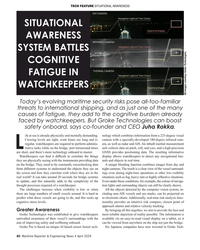 )
April 2024 - Maritime Reporter and Engineering News page: 40
)
April 2024 - Maritime Reporter and Engineering News page: 40, watchkeepers are required to perform adminis- era, as well as radar and AIS. An inbuilt inertial measurement L trative tasks while on the bridge, port turnaround times unit collects data on pitch, roll, and yaw, and a high-precision are short, and there’s more technology onboard to master. GNSS
-
 )
April 2024 - Maritime Reporter and Engineering News page: 38
)
April 2024 - Maritime Reporter and Engineering News page: 38took place at an offshore multiple buoy mooring site near pacity of 485 kWh, Castalia ensures operational autonomy of the BP re? nery, two miles from the Port of Castellón in Spain. up to eight hours, providing an ef? cient and non-polluting solu- Using its electric line handling tug Castalia, Consulmar
-
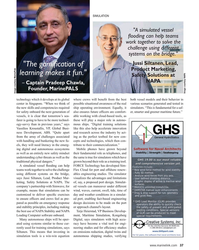 )
April 2024 - Maritime Reporter and Engineering News page: 37
)
April 2024 - Maritime Reporter and Engineering News page: 37as a training tool. A simulated vessel ? ooding can help FORCE Technology has developed Sim- teams work together to solve the challenge Flex Cloud for port and offshore renew- using different systems on the bridge, ables engineering studies. The simulator says Jussi Siltanen, Lead, Product Mar- visualizes
-
 )
April 2024 - Maritime Reporter and Engineering News page: 32
)
April 2024 - Maritime Reporter and Engineering News page: 32. in ? oating offshore wind,” says Adrian Green, Engineering & For ? oating projects, it could reduce project installation time Contracts Director. “Ports are a major bottleneck at the mo- enough to make it comparable to ? xed wind, says Green. ment, certainly in Western Europe.” The development of the
-
 )
April 2024 - Maritime Reporter and Engineering News page: 27
)
April 2024 - Maritime Reporter and Engineering News page: 27is sustaining that. We don’t Century Sailor Of? ce (N17) in my ? rst ? ag of? cer job, and have the reliefs. involved in building the “MyNavy HR” portal as a mobile, That’s my concern if we get into a large-scale, long-term op- adaptive platform for the management of our active-duty eration. We can
-
 )
April 2024 - Maritime Reporter and Engineering News page: 25
)
April 2024 - Maritime Reporter and Engineering News page: 25delayed; docks were II, for example, all of the opera- stacked high with containers; tional commander’s after-ac- rail terminals were clogged; tion reports in the Paci? c and truckers could get access to Atlantic theaters talked about the ports. “logistics, logistics, logistics.” Every senior leader
-
 )
April 2024 - Maritime Reporter and Engineering News page: 21
)
April 2024 - Maritime Reporter and Engineering News page: 21. “We are growing and evolving our services across all for more than three decades, ‘cutting his teeth’ offshore infrastructure along with our continued support to the in a UK design ? rm working in the North Sea marine industry,” said Langford. “We continue to hire key in- oil and gas platforms, the holy
-
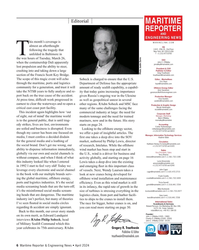 )
April 2024 - Maritime Reporter and Engineering News page: 6
)
April 2024 - Maritime Reporter and Engineering News page: 6Editorial MARITIME REPORTER AND ENGINEERING NEWS his month’s coverage is M A R I N E L I N K . C O M almost an afterthought HQ 118 E. 25th St., 2nd Floor following the tragedy that New York, NY 10010 USA T +1.212.477.6700 Tunfolded in Baltimore in the wee hours of Tuesday, March 26, CEO John C.
-
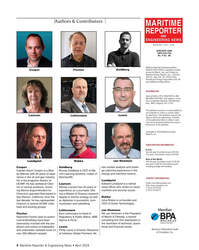 )
April 2024 - Maritime Reporter and Engineering News page: 4
)
April 2024 - Maritime Reporter and Engineering News page: 4Authors & Contributors MARITIME REPORTER AND ENGINEERING NEWS M A R I N E L I N K . C O M ISSN-0025-3448 USPS-016-750 No. 4 Vol. 86 Maritime Reporter/Engineering News (ISSN # 0025-3448) is published monthly Cooper Fischer Goldberg except for March, July, and October by Maritime Activity Reports, Inc.
-
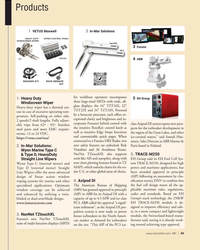 )
April 2024 - Marine News page: 43
)
April 2024 - Marine News page: 43Samuli Hän- https://vetus.com/usa/ connected to a Furuno DRS Radar, two ninen, Sales Director at ABB Marine & new safety features are unlocked: Risk Ports based in Finland. 2. In-Mar Solutions: Visualizer and AI Avoidance Route. Wynn Marine Type C NavNet TZtouchXL also supports & Type D, HeavyDuty
-
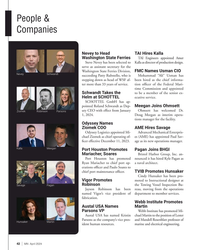 )
April 2024 - Marine News page: 42
)
April 2024 - Marine News page: 42Ziomek as chief operating of- es (AME) has appointed Paul Sav- ? cer effective December 11, 2023. age as its new operations manager. Kalla Meegan Port Houston Promotes Pagan Joins BHGI Mariacher, Soares Bristol Harbor Group, Inc. an- Port Houston has promoted nounced it has hired Kyle Pagan as Ryan
-
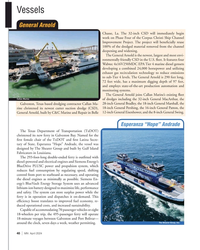 )
April 2024 - Marine News page: 40
)
April 2024 - Marine News page: 40, built by C&C Marine and Repair in Belle 12-inch General Eisenhower, and the 8-inch General Swing. Esperanza “Hope” Andrade The Texas Department of Transportation (TxDOT) christened its new ferry in Galveston Bay. Named for the ? rst female chair of the TxDOT and ? rst Latina Secre- tary of State, Esperanza
-
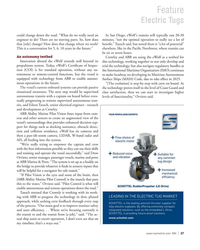 )
April 2024 - Marine News page: 37
)
April 2024 - Marine News page: 37Pilot Vision fuses input from cam- eras and other sensors to create an augmented view of the vessel’s surroundings that provides enhanced decision sup- port for things such as docking assistance, obstacle detec- tion and collision avoidance. eWolf has six cameras and then a pan-tilt-zoom camera, LIDAR,
-
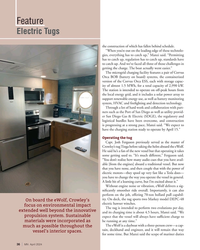 )
April 2024 - Marine News page: 36
)
April 2024 - Marine News page: 36a total capacity of 2,990 kW. The station is intended to operate on off-peak hours from the local energy grid, and it includes a solar power array to support renewable energy use, as well as battery monitoring system, HVAC and ? re? ghting and detection technology. Through a lot of hard work and collaboration
-
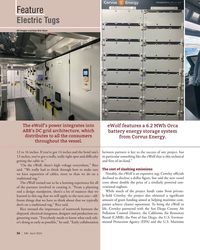 )
April 2024 - Marine News page: 34
)
April 2024 - Marine News page: 34funding aimed at helping maritime com- panies achieve cleaner operations. To bring the eWolf to don’t on a traditional tug,” Rice said. Rice stressed the importance of teamwork between the life, Crowley partnered with the San Diego County Air Pollution Control District, the California Air Resources shipyard
-
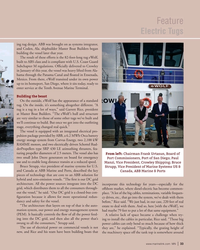 )
April 2024 - Marine News page: 33
)
April 2024 - Marine News page: 33was heavy lifted from Ala- bama through the Panama Canal and ? oated in Ensenada, Mexico. From there, eWolf transited under its own power up to its homeport, San Diego, where it sits today, ready to enter service at the Tenth Avenue Marine Terminal. Building the beast On the outside, eWolf has the appearance
-
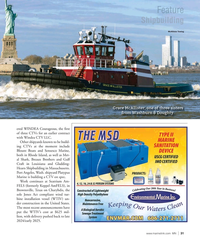 )
April 2024 - Marine News page: 31
)
April 2024 - Marine News page: 31Marine, both in Rhode Island, as well as Met- al Shark, Breaux Brothers and Gulf Craft in Louisiana and Gladding- Hearn Shipbuilding in Massachusetts. Port Angeles, Wash. shipyard Platypus Marine is building a CTV on spec. Work continues at Seatrium Am- FELS (formerly Keppel AmFELS), in Brownsville, Texas
